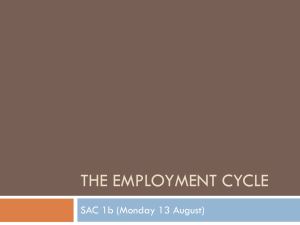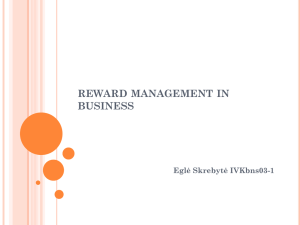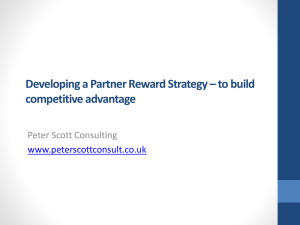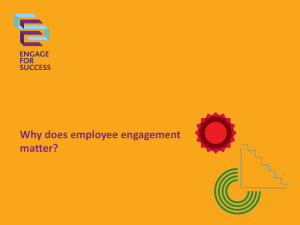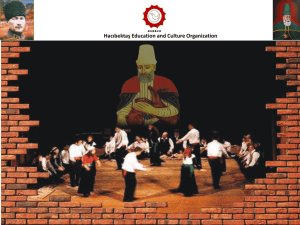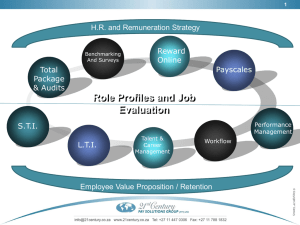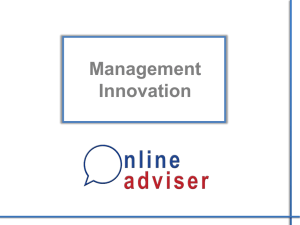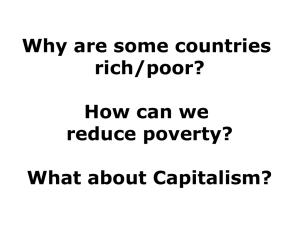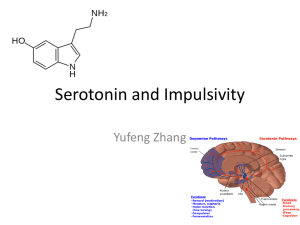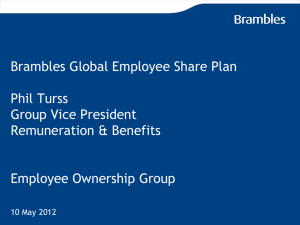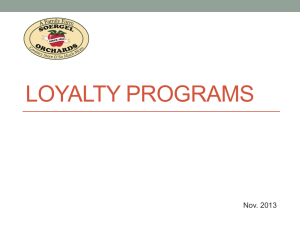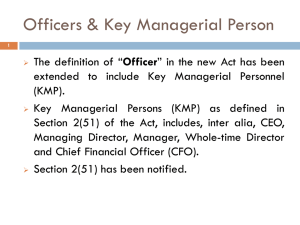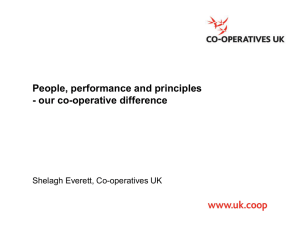Long term incentives - KeyPoint Consulting
advertisement
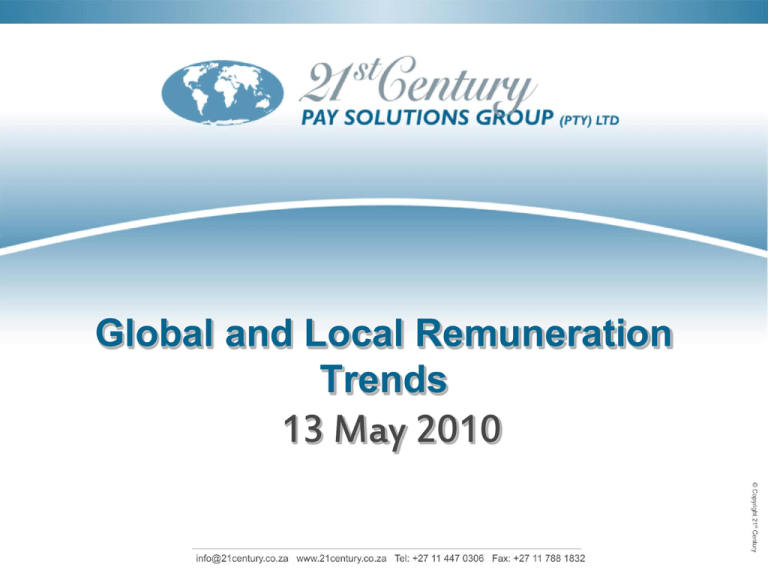
Global and Local Remuneration Trends 13 May 2010 2 Growt_ & P_ofit The world’s most successful companies have this one figured out 3 Top 15 Reward Trends 1. Employee Engagement 2. Total Reward Approach 3. Retention Trends 4. Linking Pay to Performance 5. New Long Term Incentives 6. Non-Financial Rewards 7. Globalisation 8. Governance 9. More Flexibility and Reward preferences 10. Setting Non-Executive Director (NED) Pay 11. Rewards for Creativity 12. Dual Career Paths and Flat Structures (Broadbanding) 13. Media Scrutiny 14. HR, Reward and the Bottom line 15. Branding and EVP 4 1. Employee Engagement ... Advocacy Commitment Motivation Satisfaction Engagement 5 Six Categories Drive Employee Engagement Work People • Work Tasks • Sense of Accomplishment • Resources • Work Processes • Senior Leadership • Manager • Coworkers • People Focus • Customers Total Rewards • Pay • Benefits • Recognition Company Practices • People/HR Practices • Managing Performance • Brand Alignment • Organization Reputation Engagement Opportunities • Career Opportunities • Learning and Development Quality of Life • Work/Life Balance • Physical Work Environment 6 Employee Engagement (cont.) The Big 5: Employee Engagement 1. Recognise and reward superior performance 2. Establish a learning environment 3. Create knowledge sharing 4. Manage the culture of change 5. Provide opportunities to grow and develop 7 Engagement and the Bottom Line 30% - 150% of annual salary Accountant = R250,000 (median annual salary 2009) =R250,000 x R30% =R75,000 10 – 6 – 2 Every 10% improvement in commitment can increase an employee’s effort level by 6%, which can improve an employee’s performance by 2% (10-6-2 rule). 10 : 9 Every 10% improvement in commitment can decrease an employee’s probability of departure by 9% Source: Corporate Leadership Council, Driving Employee Performance and Retention through Engagement. 8 2. Total Reward Approach Organisational Culture Business Strategy TOTAL REWARDS STRATEGY Remuneration Benefits Work-Life Performance & Recognition Human Resource Strategy REF: W@W 2008 Development & Career Opportunities Attract Employee Business Satisfaction & Engagement Performance & Results Motivate Retain 9 Remuneration Definitions and Terminology + Long-term Incentive Variable Pay + Short-term Incentive + Car Benefit + Other Benefits + Cost of employee benefits Fixed Base / Basic Salary Pay Guaranteed Package / Total Guaranteed Package Total Remuneration / Total Cost of Employment Total Earnings / Total Cost to Company Base / Basic Salary Rolling Incentive 10 Total Package Approach Total Packages concept continues to be a trend There are few tax reasons for going this route, but many other advantages of doing so Main Reason Employer Employee Cost containment Flexibility 11 3. Retention Trends Retention of critical skills and top executives is a top driver of remuneration policy and strategy People join companies and leave bosses It is all about engaging top talent Once all the hygiene factors are sorted out, then one can turn to remuneration Remuneration is 25% of the stay decision BUT, remuneration is the ticket to the game – it has to be right 12 Retention – Remuneration Options Market Stance Restraint of trade payment Sign-on bonuses/Retention bonus Sign-on Loans Rolling or banking of bonus incentives earned Flexibility Post retirement benefits Long-term incentives (LTI) Short-term incentives (STI) Deferred compensation 13 4. Linking Pay to Performance Movement away from discretionary bonus plans (determined by the Board after the fact) to target based plans (where specific performance requirements and contingent reward outcomes are set in advance) Targets are both quantitative and qualitative Not just what was paid – how did you earn it? 14 Short Term Target and Stretch Targets Percentages by Level Short-term incentive payment trends as a % of guaranteed package Performance CEO On target 30% 50% 70% 200% Stretch 50% 75% 100% 500% On target 20% 35% 60% 100% Stretch 35% 60% 80% 200% On target 15% 25% 50% 75% Stretch 25% 50% 70% 100% On target 10% 20% 35% 50% Stretch 17% 30% 60% 75% 5% 10% 15% 20% 10% 15% 25% 35% 5% 8.3% 10% 15% 8.3% 10% 15% 20% Top Executive – Reporting level 1 Senior Management – Reporting level 2 Middle Management – Reporting level 3 Advance Operational On target Stretch Operational & Primary On target Stretch Lower quartile Median quartile Upper quartile 90th quartile Title 15 5. New Long Term Incentives With the introduction of AC 139/IFRS2, companies need to evaluate different share valuation models and select one that is most appropriate to their circumstances Although AC139/IFRS2 does not prescribe share valuation models (nor offer more than cursory guidelines as to their application), the onus regarding fair valuation rests squarely on the shoulders of the external auditor as part of the fiduciary responsibility to certify the fairness of the company’s financial statements Section 8C of the Income Tax Act 16 Allocation Multiples for Employee Share Participation Schemes Decision making level Paterson Grade Roles Options as a multiple of guaranteed package Lower quartile Strategic Intent Strategic Execution Middle Management Median Upper quartile F Upper Group CEO 4X 6X 8X F Lower Top Executive – Reporting level 1 2X 4X 7X E Upper General Manager – Reporting level 2 1.5X 3X 5X E Lower Senior Management – Reporting level 3 1X 2X 3X E Upper Reporting level 4 0.5X 1X 2X 17 Options/Share as a Percentage of Package Decision making Eligibility Paterson Grade Roles Options as a multiple guaranteed package Lower quartile Median quartile Upper quartile Top Management, Strategic Intent 90% F Upper Group CEO 56% 83% 111% 85% F Lower Top Executive Reporting level 1 28% 56% 97% General Management, Strategic Execution 80% E Upper General Management – Reporting level 2 21% 42% 69% Senior Management , Strategic Execution 70% E Lower Senior Management – Reporting level 3 14% 28% 42% Middle Management, professionally qualified and experience specialists 40% D Upper Reporting level 4 7% 14% 28% 18 6. Non-Financial Rewards Recognition Clearer career paths Development opportunities Job enrichment Tuition of choice Mentoring and coaching Internships Rotation and Learning 19 lternatives to cash 20 Your Total Rewards Inventory Work-Life Workplace Flexibility Paid and Unpaid Time off Community Involvement Flex-Time Maternity/Paternity Leave Community Volunteer Programmes Telecommuting Adoption Leave Matching Gift Programmes Alternative Work Sites Sabbaticals Shared Leave Programmes Compressed Work Week Disaster Relief Plans Job Sharing Sponsorship Grants Part-Time Employment In-Kind Donations Seasonable Schedules 21 Your Total Reward Inventory Work-Life (cont) Caring for dependents Dependent Care Reimbursement Accounts Dependent Care Reimbursement TravelRelated Expense Dependent Care Referral and Resources Services Dependent Care Discount Programmes or Vouchers Emergency Dependent Care Services Childcare Subsidies On-Site Caregiver Support Groups On-Site Dependent Care Adoption Assistance Service After-School Care Programmes Scholarship Information Scholarships Privacy Rooms Holiday Camps & Activities Special Needs Childcare Disabled Adult Care Geriatric Counselling In-Home Assessments for Eldercare 22 Your Total Reward Inventory Work-Life (cont.) Health and Wellness Employee Assistance Programmes Onsite-Fitness Facilities Discounted Fitness Club Rates Weight Management Programmes Smoking Cessation Assistance On-Site Massages Stress Management Programmes Voluntary Immunisation Clinics Health Screenings Nutritional Counselling On-Site Nurse Business Travel Health Services Disability Management Return to Work Programmes Reproductive Health/Pregnancy Programmes 24-Hour Nurse Line On-Site Work-Life Seminars e.g. Stress-Reduction, Parenting, etc. Health Advocate 23 Your Total Reward Inventory Work-Life (cont.) Financial Support Voluntary Benefits Culture Change Initiatives Financial Planning Long Term Care Work Redesign Adoption Reimbursement Auto/Home Insurance Team Effectiveness Transit Subsidies Pet Insurance Diversity/Inclusion Initiatives Legal Insurance Woman’s Advancement Initiatives Identity Theft Insurance Work Environment Initiatives Employee Discounts Multigenerational Initiatives Concierge Services 24 Your Total Reward Inventory Performance and Recognition Performance Recognition 1 on 1 Meetings Service Awards Performance Reviews Retirement Awards Project Completion/Team Evaluations Peer Recognition Rewards Performance Planning/Goal Setting Spot Awards Managerial Recognition Programmes Organisation-wide Recognition Rewards Exceeding Performance Rewards Employee of the month/year Rewards Appreciation Luncheons, Outings, Formal Events Goal-Specific Awards i.e. quality, costsaving Employee Suggestion Programmes 25 Your Total Reward Inventory Development and Career Opportunities Learning Opportunities Coaching/Mentoring Advancement Opportunities Tuition Reimbursement Leadership Training Internships Tuition Discounts Exposure to Resident Experts Apprenticeships Corporate Universities Access to Information Networks Overseas Assignments New Technology Training Formal/Informal Mentoring Programmes Job Advancement/Promotion On-the-Job Training Internal Job Postings Seminars and Conferences Career Ladders and Pathways Virtual learning Succession Planning On/Off Ramps through Career Lifecycles Job Rotations 26 7. Globalisation Remuneration Trends Act local Think Global 27 Glopats want to know that: Their pay is competitive They will not be worse off (and that hardship is taken into account) Living standards are upheld Their purchasing power parity (PPP) index is upheld Sufficient and adequate pension arrangements are made 28 8. Governance More focus on independence of NED’s Learning to strike the balance between good governance and being too transparent The question being asked is: “If we disclose all our remuneration data, schemes and how they operate, we are giving our competitive advantage away” King III implemented 29 9. More Flexibility and Reward Preferences More flexible working arrangements for employees and the organisation Five year contracts with handsome “completion” bonuses are increasingly popular in South Africa, and this approach serves several goals Reward preferences by Life Cycle, MBTI 30 Generations, now life cycle and Reward Generations Veterans (born before 1940 Baby Boomers (1940-1960) Generation X (1960-1980) Generation Y (1980-2000) Reward practice – what each generation values from an organisation Extra days leave Recognition schemes Flexibility Non-financial incentives Sponsor education programs Services for staff Challenging projects Fun Workplaces Good Guaranteed packages and short-term incentives Reward Meaningful work “Grand Celebrations” 31 Why do we call the last long generation Y. I did not know, but a caricaturist explains it eloquently below... Learned something new! 32 Personality type and reward preference Nienaber & Bussin, 2009 33 Reward categories influencing attraction, motivation and retention of employees Attract Retain Motivate Monthly Salary/guaranteed remuneration 73.5% 19.7% 9.8% Variable Pay 5.4% 22.1% 29.7% Benefits 3.1% 7.0% 1.8% Performance & career management 8.9% 27.0% 34.3% Quality of work environment 1.8% 3.3% 6.2% Work/home integration 7.3% 20.9% 18.1% 100% 100% 100% Nienaber & Bussin, 2009 34 10. Setting Non Executive Director (NED) Pay Should they all earn the same Should they get shares to align with agency theory? Should they get an incentive bonus to reward great decisions? The trend will be to differentiate NED pay 35 A typical NED Pay Model Organisation size, complexity, impact, strategic level Lower quartile/P25 Median quartile/P50 Upper quartile/P75 90th quartile/P90 A R 900 000 R 1000 000 R 1100 000 R1200 000 B R 700 000 R 800 000 R 900 000 R 1000 000 C R 500 000 R 600 000 R 700 000 R 800 000 D R 300 000 R 400 000 R 500 000 R 600 000 E R 100 000 R 200 000 R300 000 R 400 000 Knowledge Experience Track Record Reputation Executive Factors 36 37 11. Rewards for Creativity If people bother to put forward suggestions, they should be recognised for this effort If everyone gets into the habit of making a creative effort then, there will be valuable ideas It is at least as important to motivate people who do not see themselves as creative to become creative, as it is just to choose already creative people 38 Paying for This There is a wide range of payment plans ranging from: A pharmaceutical company is paying a maximum of R 10 000 per idea An FMCG pays R 500 000 for the best idea of the year A consultancy lets you choose your own reward A bank pays R1m for the best idea 39 12. Dual Career Paths and Flat Structures (Broadbanding) Broadbanding is hugely seductive to organisations who want to become HPO’s (High performing organisations). The reason is that the million of hours spent doing job grading and fighting about miniscule changes in the job description leading to non-value-add- upgrades can now be spent on performance. 40 SST - Dual Career Path Approach PATERSON SST LINE Specialist DESCRIPTIONS TOP MANAGEMENT F 5 E 4 D 3 MIDDLE MNGT 2 FIRST LINE SUPERVISORS C Upper C Lower 1 B 1 A 1 SNR. MNGT SI - Corporate strategic direction and policy signoff GROUP / FUNCTIONAL / ADVISOR SE - Translation of corporate direction into organisation planning & management PROFESSIONALS / SPECIALIST MP - Translation of organisation plans into functional plans and best practice systems TECHNICIAN / PRACTITIONER SP - Optimizing a given system to achieve plans ADVANCED OPERATIONAL OPERATIONAL SKILLS PRIMARY SKILLS AO - Solving a range of technical problems within a recognized technical discipline through the appropriate use of tools O - Routine application of industry specific tools and equipment which require training but not discipline apprenticeship P - Routine task orientation using simple tools and equipment normally of a manual nature 41 Retention - Skill Categories Critical Skills: Skills critical to sustain its business objectives. It is essential that these skills are in place to ensure business continuity Scarce Skills: Determined by the demand and supply of a particular skill in the market. The situation changes over time when the skill pipeline facilitates more people acquiring this level of skill High Fliers: Consistently high performers as per performance standards Core Staff: Support areas Employees who work in the operational areas Staff: Employees who work in non-core or support 42 Specialists Professional Resource/Technical Management Traditional Management General/ Manager Critical Skills Engineering Management PATERSON BAND DESCRIPTER F Top management EU “Phd” Engineer Principal Engineer Senior Engineer EL DU DL Engineer CU Graduate Engineer (Trainee) General Management Senior management / Specialist Middle management / Senior Professional Management / Professional Supervisory / Advanced Operational CL Technical / operational BU Administrators/ Operational BL Clerical A Basic skills 43 Scarce Skills cont. . . Employee A MAX 10% Scarce Skills Allowance Employee B MID Employee C MIN Employees A, B and C all get an allowance calculated from the MIDPOINT of the salary scale irrespective of where they are paid relative to their peers P50 44 13. Media Scrutiny Executive Pay – too much or too little? 45 Most Common Determinants of Pay Organisation Size - turnover, number of employees, value of assets Organisation Performance - profitability, return on investment, value added Executive Specific Factors - Age, experience, tenure, career path Organisation Structure - Holding, subsidiary or single unit company, capital or labour intensive Job or Position Specific Factors - level of decision making, consequence of error, organisation level Job Complexity 46 Considerations when choosing market comparators: Holding, subsidiary or single unit organisation Private, public or state owned enterprise Monopoly or many competitors Complexity of industry or market Listed or not Local listing only (JSE) or overseas listing e.g. LSE, NYSE or both Organisation size in terms of turnover, budget, profit, assets, market cap, number of employees 47 Considerations when choosing market comparators (cont.): Job content, not just position title Job size – not all CEO job sizes are the same Performance of organization in terms of financials, shareholder return, strategic vision, people management practices Geographic footprint Ownership structure Extent of regulation 48 14. HR, Reward and the Bottom line Ref: Watson Wyatt 49 The higher the company’s HCI score, the higher the TSR 50 The Watson Wyatt HCI “Global Truths” Companies with superior human capital practices can create more than double the shareholder value than companies with average human capital practices Companies have better TSR if they have: Clear Rewards and Accountability – delivering a 16.5 to 21.5% Excellence in Recruitment and Retention – delivering a 5.4 to 14.6% A Collegial, Flexible Workplace – delivering a 9.0 to 21.5% 51 The Watson Wyatt HCI “Global Truths” (cont.) Communication Integrity – delivering a 2.6 to 7.1% Focused HR Technology – delivering a 4.2 to 6.5% Prudent Use of Resources – potentially draining shareholder value by as much as 14.5 to 33.9% The Bottom line: Great people management equals great shareholder value Great people management is universal Great HR can be a true source of competitive advantage 52 15. Branding / EVP Branding Is there a remuneration discount when you work here? How much? THANK YOU for this opportunity to be with you

